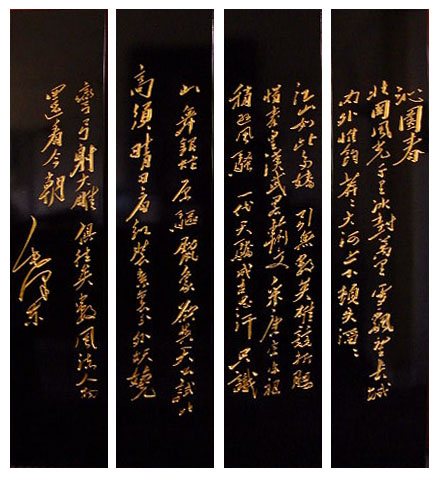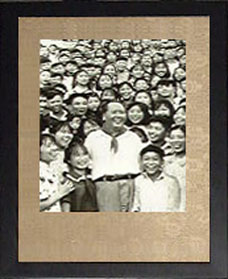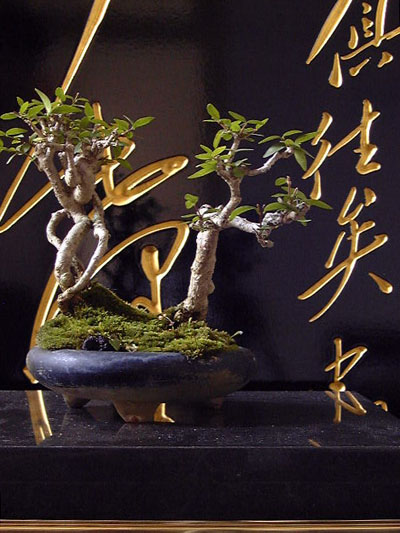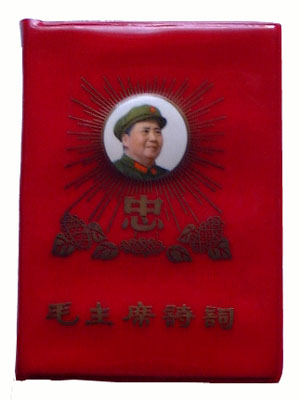|
COMMON
SENSE AESTHETICS
X
By Mimi Hockman : ID Magazine
Oct
| Nov 1997
X

Andrew Jones Ed Poole
|
MIMI HOCKMAN catches up with Ed
Poole and Andrew Jones of the six and a half year-old architectural and
design firm POOLE ASSOCIATES, during a pause in their dizzy schedule,
for some lively conversation on their distinctive brand of work. The two
have just returned the night before from Beijing where they had gone to
investigate and source for their current project, House of Mao. In
between mouthfuls of Fiddleheads' delectables, they speak about their
'fresh insight' approach to design, past and current jobs, sources of
inspiration -- and being expats doing 'New Asian' designs.
(About visiting Beijing for the House
of Mao)
ED I suppose you could call what we're trying to
create 'a casual theme restaurant called the House of Mao.' So we needed
to go and get the feel of what it must have been like back in the '50s
and '60s. That and to taste the food. It's quite spicy, this Hunanese-type
fare. Our design was already 50% done, but now we'll make a couple of
alterations to make it a little bit more authentic....
Based on the food?
ED Well, the food and just getting a feel for the
character of Beijing. We were also looking for authentic things, like
these light fittings that are from Tiananmen Square.
Where is (House of Mao) going to be?
ED Down here on Telok Ayer Street at the China
Square Food Centre.
ANDREW (Beijing) was a much more modern city than
we expected it to be. Much more organized.
E The architecture is very monumental...
A ...planned to the nth degree.
E There are these tremendous trees lining very
wide boulevards. Every building is very classically oriented with
pediments and Schinkelesque symmetry, but all with a Chinese twist to
it. Even the modern buildings are great. And the railway station is
incredible.
With this project I suppose the answer is fairly obvious, but with
your other jobs, by what criteria do you decide how the design should
be?
E The first thing obviously is the brief by the
client, second would probably be the location, where a project fits
within the city, or even within a specific building...
...and that would influence the design?
E ...yes, of course it would, because often when
you go into a room or a space and you know what the program is, whether
it's going to be a restaurant or an office or whatever, you can get a
general read of the space to feel what will be a comfortable, logical
orientation for the layout. Then, after that, of course, there'd be the
budget and then the commercial viability of what we're doing.
...meaning what?
E Well, for instance, if someone tells us they
want to do another cafe, we say 'do you seriously want to enter a
saturated market...'
A ...when there are lots of big boys already
playing the game, can we really take them on?
E We've kind of learned the hard way that while
we're always trying to push the aesthetics of new design, we can't go
too far because if people don't relate to it, then it won't work in
Singapore. The market here is just too small to not be very careful
about commercial viability.
A And in these niche markets, you need to
understand the types of people whom you're dealing with, who live or
work in that area. And cater the design to suit that target clientele.
E A good example of that would be the Haagen-Dazs
at Century Square (in Tampines) versus the design for Qhue at Pasir
Panjang Village. The design approach from the very beginning would be
totally different because the demographics are worlds apart.
What percentage of your work now is residential and what percentage
commercial?
E Well, our current residential projects will be
our last.
A It's the most difficult, time-consuming and
least cost effective thing to get done. If you don't have a client who
is clued in with your vision, it can be very soul-destroying. We find
that many people are attached to that well-worn sofa from University
days and it's very difficult to get them to move away from that and go
in a more refined and minimalist direction.
E Yes, that always irritates me tremendously --
when a client says 'oh, let's just throw this into the corner of the
room'. It's important to plan where things can go, especially if they're
monumental pieces. They need to have a place to be put that makes sense
of the overall scheme.
Do you find that each successive job is an evolution of the one that
came before? And do you feel you can go a little bit further from the
last job?
E Yes and no. You can be going in one direction
but you're also veering off into all these different paths at the same
time. And sometimes a path is cut altogether, but might be resurrected
again several years later because of some new design movement where the
market now accepts something that it didn't before. And of course, each
client is different, so we can't repeat the same thing.
A There's actually the demand of time and the
client's money to consider. As soon as they put down a deposit or rental
on the lease, the clock is ticking and they want us to produce as
quickly as possible. It's difficult to always be coming up with new
ideas all the time. You have to go out there and find other influences
or hope the client will come to you with a brief that you haven't really
thought of before. That can take you off in a completely different
direction, but you have to do some research very quickly and find out
what it is they're looking for and whether it fits the market.
Do you have many clients that come to you with inspired ideas or
ideas that inspire you?
E Oh yes, definitely. In fact, House of Mao is a
very good example. The client was very clear about what he wants to have
happen and now we're developing that idea together. It's going to be a
multi-layered expression when it's done, with a lot of sublime messages.
It's not going to be a take-off of the China club in Hongkong?
E Oh no, no. That's way more upmarket. House of
Mao is about frugality. A basic noodle bar kind of thing, but very fun
-- a little tongue-in-cheek in a way.
Is this going to be an outlet specific to Singapore or regional?
E They have plans to go abroad as well.
Do you find that most of your business is in Singapore or do you
have a lot of projects abroad?
E Right now it's mostly here but a year and a
half ago, we were actually doing 90% outside, mostly in Indonesia.
How do you get most of your jobs?
E We don't get them, they come to us. We have
never gone out specifically to market ourselves.
But how does it happen?
A First, of course, there's our reputation for
quality work. And some of it comes through publications and design
magazines, and these magazines tend to circulate within the design
community -- which is not necessarily where commercial clients would
look. You do find that residential clients will go and look in a
magazine if they're looking to do a new apartment. One recent client
came to us having seen something of ours in a magazine and now we're
doing her flat, but things like office jobs tend to be referrals. A lot
of the time it's the same company coming back, moving into a new
building or needing expansion space. For example, we've been working
with DY&R (Dentsu, Young and Rubicam) for 6 years now.
Tell me a little bit about where your ideas and inspiration comes
from.
E That's an interesting question -- interesting
in a philosophical sense. Where does any inspiration come from?
Well, Jungian philosophy aside, I realise it's going to be different
for every project but for instance, with (a private apartment in Casa
Rosita), did you derive any of your ideas from your concept of the
owner?
E As with any job, the first thing is the format:
he wanted to knock out a bedroom because it wasn't useful and turn it
into another function. He didn't like the cramped feel of the dining
room and he had a general idea of a certain kind of ambience he wanted,
certain kinds of materials. He also had a collection of art that he
wanted to display. Out of that we started to get an overall picture.
Then you enter into more conversations, and eventually, the job
develops. In his case, we saw that he was very open-minded so we started
throwing in ideas about using some very strange materials, but you know,
the horse hair-lined cabinets did not get built.
So with that you drew from his character and his criteria, and with
commercial food projects, you might get some inspiration from the food
itself...
E Well, with Rubino's, we started with the
concept of ribs. What are ribs about? What is the history of ribs. And
that's how we ended up with Bobby Rubino's, a kind of 60's jazz supper
club atmosphere. There's always some kind of generating factor. A lot of
it is just keeping your ears open and listening to what the client is
telling you, and sometimes what they're not telling you.
A Then quite often, you have to interpret that
and take it further than what they think they want, because quite often,
they're not clear.
E It's a matter of trying to pick up on clues
that will lead us to the next level.
Do you find that clients are generally agreeable to your ideas or
does it take some convincing?
A It's not like, they talk to us, then we go away
and spend two weeks doing something and then we get back to them. We're
always in contact. The thing becomes a synergy between us and them and
we're all going in the same direction.
E So we tend to hit on one idea and go with that.
But we never submit scheme a, b and c and then convince them to go with
one. And so far, we've never had an idea rejected, because a solution is
based on logical common sense.
How do you find the competition here? And who would be the
competition?
E What competition...?
...Of course.
E But seriously, the Singapore economy is still
so buoyant, there's a lot of open scope for lots of different kinds of
projects. We really don't compete against other firms.
A We do have clients who come to us and say that
they are talking to other designers...
And when that happens, who are those people or firms?
E Hirsch Bedner, Bedmar & Shi, Tony Chi
Associates, Andree Putman...
Does being expats in Singapore have any impact on your doing design
business here?
E My one complaint about doing business here is
that the cost of living is higher for foreigners because we don't have
the opportunities of housing. You're stuck with very little opportunity
for your basic need, which is housing. Consequently, the fees must be a
little bit higher. The smallest shophouse on this island is at least
$1.5 mil and that's what, twenty thousand dollars a month on a mortgage
which is, let's face it, just not possible on today's design fees. So,
we're out of the market for HDB and can't go into private property. It
causes me to question whether there is any long term viability because
I'm losing my retirement to rent.
But, as expats, you don't feel discriminated against when it comes
to getting jobs?
A No, that's never been a problem, it's just, as
an expat, it's difficult to live in Singapore because of the expense. We
have, however, had a few Asian clients who approach us to do an Asian
concept and they will say to our face, 'How can you do an Asian concept,
you come from the UK and America, what do you know about Asia?' And all
we can answer is that Ed's been here for eight years and I've been here
for four, and we've kept our eyes open. Actually, it's easier for us to
look at what's interesting from the outside as we tend to pick up things
that a lot of locals miss because it's too common to them. We have the
benefit of fresh insight. Also, we tend to re-evaluate the old things
whereas a lot of the local designers only look for new things. And all
the new stuff generally comes from the west.
What's been your biggest project to date?
E Biggest, as in most influential, would have to
be the restaurant, Blue Ginger.
A It seemed to focus the direction of the company
and at the same time, really crystallize our ideas.
E We didn't necessarily get jobs from it! But I
find that we're on these kind of parallel paths where certain design
ideas perpetuate and yet morph with each new job. One of those paths is
a sort of non-design, for instance, with Hooters. But Blue Ginger was
the node on the path which we like to call 'New Asian' Design. This
includes projects like DY&R, Qhue, China Jump, House of Mao, and the
Casa Rosita apartment, to some respect.
Besides House of Mao, what other projects do you have in the works
now?
E The Singapore Police Association for National
Servicemen's clubhouse on Orchard Road, a large penthouse in Holland
Village, an apartment in Regency Park, Revox in Suntec City, the British
Council renovation of their lobby and office, DDB Singapore, the
headquarters for Jay Gee Enterprises (Levi's)...(to Andrew) is that all
(on the list)? |








